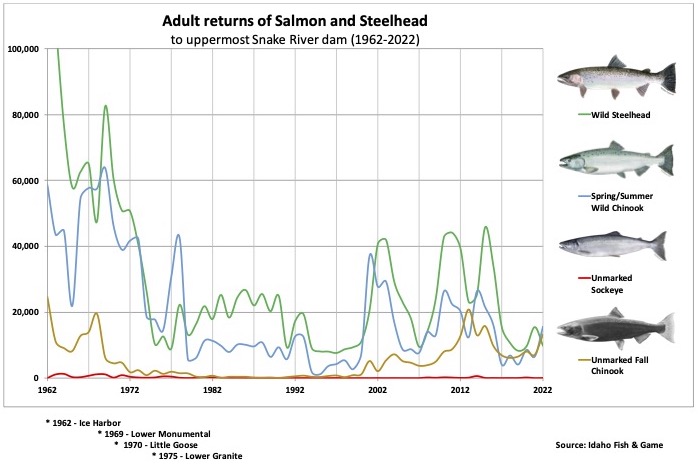forum
library
tutorial
contact

Comparative Survival Study Analyzes
Recent Spill Impacts on Salmon
by K.C. Mehaffey
NW Fishletter, May 1, 2023
|
the film forum library tutorial contact |

|
Comparative Survival Study Analyzes
by K.C. Mehaffey
|
"But in reality, spill hasn't changed much" since CSS started gathering data in 1996. -- Jonathan Ebel, Idaho Department of Fish and Game
 Broad conclusions in this year's comparative survival study include that high spill levels in 2020 and 2021 at eight federal dams on the lower Snake and Columbia rivers have reduced the likelihood that juvenile fish will encounter turbines or bypass systems on their way to the Pacific Ocean, reducing the potential for delayed mortality.
Broad conclusions in this year's comparative survival study include that high spill levels in 2020 and 2021 at eight federal dams on the lower Snake and Columbia rivers have reduced the likelihood that juvenile fish will encounter turbines or bypass systems on their way to the Pacific Ocean, reducing the potential for delayed mortality.
Also, spilling water over the dams to reach a 125-percent total dissolved gas saturation level has had no discernable impact on juvenile survival, at least so far, although since most adults from the 2020/2021 smolt years haven't yet returned, it's too soon to know the impact of high spill on smolt-to-adult returns.
The CSS is a multiagency monitoring project that gathers and analyzes PIT-tag data on steelhead, sockeye, and spring, summer and fall Chinook in the Columbia Basin.
Ongoing since 1996, the study follows cohorts of salmon and steelhead populations, and scientists use that data to help determine freshwater conditions that aid in salmonid recovery.
During one of its CSS reviews, the Independent Scientific Advisory Board noted that many things have changed in the hydro system since the study's data collection began, and asked for a list of major changes in the system and their effects on salmon and steelhead survival.
But the latest study says a complete listing of changes is infeasible, given the multitude of different operations at different dams, some of which change from week to week. The CSS says there have also been numerous fish passage infrastructure improvements that make comparison between years difficult, such as the addition of spill deflectors, spillway weirs and ladder cooling structures.
However, Chapter 7 of the CSS added to this year's study does provide a broad summary of changes relevant to general fish performance in the hydro system in response to the ISAB request.
The chapter notes that spill occurs for three primary reasons -- when flows exceed the capacity of turbines to use the water to generate electricity; when flow exceeds the need for hydroelectricity; and when managers want to provide an alternative to fish bypass systems or turbines -- known as a powerhouse encounter -- for fish passage. The CSS maintains that smolts that encounter the powerhouse, either through turbines or through a bypass system, are more likely to experience delayed mortality after leaving the hydro system.
The chapter concludes, "Certain changes in spill implementation had visible direct or indirect effects on some CSS metrics, particularly [powerhouse encounters], the percentage of juveniles transported, and fish travel time to a lesser extent. However, that change in spill had to be significant to influence these metrics, such as the provision of spill at low flows in the Lower Snake River after 2005 or the shift to a 125% TDG gas cap in 2020."
And, it states, "Because of the relatively minor changes in spill since the inception of the CSS, the impact of those changes on metrics such as juvenile survival and SAR are difficult to discern in the time series. Said another way, the effect of the spill program, as implemented, is small such that it is easily swamped by variations in total river discharge and ocean conditions. The most recent and most significant change in voluntary spill has occurred in the past three years and the potential influence on SAR will be unknown until adult returns are complete."
Jonathan Ebel, fisheries staff biologist for the Idaho Department of Fish and Game, gave an overview of the chapter during the Fish Passage Center's annual meeting on April 19. He noted that spill at Lower Granite Dam could be broken into three eras -- the pre-listing era before 1996 when there was no voluntary spill; the biological opinion era from 1997 through 2017 when there were spill thresholds or fixed volume spills; and the court-dominated era since 2018 during which higher spill levels have been required.
"Spill changed a lot on paper," Ebel said. "But in reality, spill hasn't changed much" since CSS started gathering data in 1996. "It wasn't until the last few years that we saw significant change" in spill, he added. In 2020, the flexible spill agreement pushed spill to 125 percent of total dissolved gas saturation at most of the dams for 16 hours a day.
According to graphics he showed at the annual review, the average number of powerhouse encounters for each Chinook and steelhead smolt detected at Lower Granite Dam went from between roughly three and four in 1998 to between two and three in 2019. Ebel noted that in 2001, there was no spill due to power emergencies, and each smolt experienced roughly eight powerhouse encounters.
Powerhouse encounters for both Chinook and steelhead under the high spill conditions of 2020 and 2021 dropped to between zero and one.
learn more on topics covered in the film
see the video
read the script
learn the songs
discussion forum
